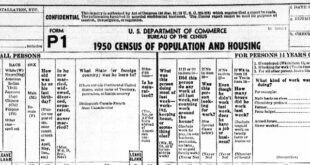A major new block of genealogy data has recently been released! Every 10 years, genealogists await the release of the U.S. Census Population Schedules. After a federally mandated 72-year waiting period, they release the names and data of everyone who was enumerated in the census. Prior to the 72-year wait, you can find demographic data, such as ethnic trends, but not the list of everyone’s name.
When the 1920 census was released in 1992, there were no on-line genealogy web sites. The only way for people to look up their families was to go to the National Archives on 73rd and Pulaski and look at microfilm. They only had a limited number of microfilm readers and a line six blocks long! This was the case for all the census releases prior to 1992 as well. Back in those days, the index (such as it was) contained only the head of household. So if you were looking for John Smith, lotsa luck!
In 2002, when they released the 1930 census, ancestry.com and genealogy.com both indexed the entire census, but it took about a month for the index to go on-line. It was quite slow due to the overwhelming demand. But they indexed every name, including the kids. So if you were looking for John Smith and his wife Evangeline, you could at least try to find Evangeline to narrow the search a little.
One of the major issues with census data is that it is difficult to verify its accuracy. Many people lived in multi-unit dwellings, especially in big cities, and many people had to work to make enough money to feed the family, so there was not always someone home when the census taker came to call. This sometimes meant that the family was not included in the census at all. Frankly, if the head of household was not established with American citizenship, it’s not surprising for them to avoid the census taker altogether! If both parents worked, and the kids were at school, their information might be provided by another family living in another apartment in that house. They might get the names right, but do they really know the year of immigration or the number of years married? (Heck, even the husband forgets sometimes!)
Okay, so what are we going to learn about our ancestors in the 1940 census? More to the point, what will we learn that was not available in previous censuses? Well, for the first time, they asked a series of standard questions for everyone, and then picked everyone on line 14 and 29 of each census paper to ask a series of supplemental questions. Remember when they took the 2000 and 2010 censuses and a lot of people were upset that the government was asking them how many toilets they had and other personal information? Well 1940, is the first time they did the “extended form.”
So the questions they asked were:
- House number and street name, and whether the home was owned (and the value) or rented (and the monthly rent).
- Names of everyone in the household, with “Ab” next to the names of people who were absent when the census taker came to call, and an “X” next to the name of the person who provided the information. (The “Ab” and “X” are new for 1940.) By knowing WHO gave the information, we can better evaluate how accurate it is. A 12-year-old child might be less reliable than the mom.
- Relationship to the head of household.
- Gender, color/race, age at last birthday, marital status (Single, married, widowed, divorced).
- Education (New to 1940) — Did this person attend school in the past month, and the highest grade or degree completed.
- Place of birth — This, like 1930 and earlier censuses, will only list the U.S. state or the foreign country, not the name of the town. They asked what country it was “as of 1937,” because by 1940, half of Europe belonged to Germany. Maurice Chevalier was born in what was, for the moment, “Germany.” So was Ignace Paderewski, the Polish pianist!
- Citizenship status of the foreign born — Don’t be surprised if Papa lied a little on this question!
- Residence on April 1, 1935 (New to 1940) — We get to see if they moved within the past 5 years)
- Employment of anyone over 14 years old (new to 1940) — this question was asked partly to see how many kids were working instead of attending school. But it also established how many people were on government work programs that were created in the wake of the Depression
- Income in 1939 (new to 1940) — They never asked about income prior to this census.
For the 5 percent of the population who ended up on line 14 or 29, these were the supplemental questions they were asked:
- Native language
- Is the person a military veteran, or are they the spouse or child of a veteran? Is the veteran living or dead?
- Social Security number, if any
- Usual occupation
Only women had to answer these questions:
- Number of marriages
- Age at first marriage
- Number of children born excluding stillbirths
It looks like we lost some data from the 1930 census. In 1930, they asked every husband or wife their age at marriage and how many children, and the number of years in the country. They focused on employment status and military status in 1940, due to the Depression and the war in Europe.
Okay, now that you know all that, where can you find it? This time there are many places to be able to search, which should help ease the demand on computer servers a little. The National Archives has free access at 1940census.archives.gov. It is also available for free at www.familysearch.org and as part of a subscription at www.ancestry.com. The indexes were not available when the data was released on April 2, but should be close to complete as you read this.
Next month, I’ll compare the websites and search techniques. Can’t wait!
Feel free to e-mail me with questions at italianroots@comcast.net.
 Fra Noi Embrace Your Inner Italian
Fra Noi Embrace Your Inner Italian





